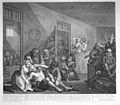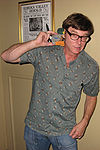Portal:Cartoon
The Cartoon Portal

A cartoon is a type of visual art that is typically drawn, frequently animated, in an unrealistic or semi-realistic style. The specific meaning has evolved, but the modern usage usually refers to either: an image or series of images intended for satire, caricature, or humor; or a motion picture that relies on a sequence of illustrations for its animation. Someone who creates cartoons in the first sense is called a cartoonist, and in the second sense they are usually called an animator.
The concept originated in the Middle Ages, and first described a preparatory drawing for a piece of art, such as a painting, fresco, tapestry, or stained glass window. In the 19th century, beginning in Punch magazine in 1843, cartoon came to refer – ironically at first – to humorous artworks in magazines and newspapers. Then it also was used for political cartoons and comic strips. When the medium developed, in the early 20th century, it began to refer to animated films that resembled print cartoons. (Full article...)

In print media, a cartoon is a drawing or series of drawings, usually humorous in intent. This usage dates from 1843, when Punch magazine applied the term to satirical drawings in its pages,[1] particularly sketches by John Leech.[2] The first of these parodied the preparatory cartoons for grand historical frescoes in the then-new Palace of Westminster in London.[3]

Sir John Tenniel—illustrator of Alice's Adventures in Wonderland—joined Punch in 1850, and over 50 years contributed over two thousand cartoons.[4]
Selected article -
Eagle was a seminal British children's comic, first published in April 1950. It was founded by Marcus Morris, an Anglican vicar, who felt that the church was not communicating its message effectively. Simultaneously disillusioned with contemporary children's literature, he and artist Frank Hampson created a dummy comic based on Christian values. Morris hawked the idea to several publishers, with little success, until Hulton Press decided to take it on. Following a huge publicity campaign, the first issue sold about 900,000 copies. Featured in colour on the front cover was the comic's most recognisable story, Dan Dare, Pilot of the Future (pictured). Other popular stories included Riders of the Range and P.C. 49. Eagle also contained news and sport sections, and educational cutaway diagrams of sophisticated machinery. Amidst a takeover of the comic's publisher and a series of acrimonious disputes, Morris left in 1959; Hampson followed shortly thereafter. Although Eagle continued in various forms, a perceived lowering of editorial standards preceded plummeting sales, and it was eventually subsumed by its rival, Lion, in 1969. A relaunched Eagle ran for over 500 issues between 1982 and 1994.
Selected character -
Homer Simpson is a fictional main character in the animated television series The Simpsons. Homer is the boorish father of the Simpson family and as the family's provider, he works at the Springfield Nuclear Power Plant. With his wife, Marge, he has three children: Bart, Lisa, and Maggie. Homer embodies several American working class stereotypes: he is crude, overweight, incompetent, clumsy, lazy and ignorant; however, he is also fiercely devoted to his family. Homer was created and designed by cartoonist Matt Groening. He is voiced by Dan Castellaneta and first appeared on television, along with the rest of his family, in The Tracey Ullman Show short "Good Night" on April 19, 1987. After appearing on The Tracey Ullman Show for three years, the Simpson family got their own series on Fox, which debuted December 17, 1989. Homer is one of the most influential fictional characters on television and has inspired an entire line of merchandise. His catchphrase, the annoyed grunt "d'oh!", has been included in several dictionaries. Castellaneta has won four Primetime Emmy Awards for Outstanding Voice-Over Performance and a special achievement Annie Award for voicing Homer.
Did you know... -
- ...that publication of comics in Hungary largely stopped during World War II due to Nazi pressure?
- ...that the Fire Nation, from the Universe of Avatar: The Last Airbender, was inspired by photos of volcanic islands of Iceland and the Pacific Ocean?
- ...that after bad reviews, the distributors of the 1992 animated film The Princess and the Goblin used enthusiastic comments from children in its promotional material?
- ...that The World of Strawberry Shortcake, the first television special to feature American Greetings' popular character, was rejected by the major U.S. networks and premiered in syndication instead?
Selected list -
The episodes of The Simpsons, an American animated sitcom, created by Matt Groening (pictured) for the Fox Broadcasting Company. The series is a satirical parody of a middle class American lifestyle epitomized by its eponymous family, which consists of Homer, Marge, Bart, Lisa, and Maggie. The show is set in the fictional town of Springfield, and lampoons American culture, society and television, and many aspects of the human condition. Groening created a dysfunctional family and named the characters after members of his own family, substituting Bart for his own name. Since its debut on December 17, 1989, The Simpsons has broadcast 782 episodes. The Simpsons holds several American television longevity records. It is the longest-running prime time animated series and longest-running sitcom in the United States. The series has surpassed Gunsmoke in seasons to claim the spot as the longest-running American prime-time scripted television series.
General images -
Selected biography -
Joseph Barbera (1911–2006) was an influential American animator, film director, film producer, storyboard artist, and cartoon artist. Born in New York City, after working odd jobs and as a banker, Barbera joined Van Beuren Studios in 1932 and subsequently Terrytoons in 1936. He met his lifelong collaborator William Hanna while working for Metro-Goldwyn-Mayer in 1937 and soon began producing animated shorts such as the Tom and Jerry series. In 1957, after MGM dissolved their animation department, they co-founded Hanna-Barbera, which became the most successful television animation studio in the business, producing programs such as The Flintstones, The Huckleberry Hound Show, Top Cat, The Jetsons, Scooby-Doo, The Quick Draw McGraw Show, The Smurfs, Wacky Races and Yogi Bear. Hanna and Barbera won seven Academy Awards and eight Emmy Awards. Their shows, which have translations in more than 20 languages, had a global audience in the 1960s of over 300 million people.
Subcategories
WikiProjects
- Main projects
- Arts • Animation • Comics • Entertainment • Visual arts
- Related Projects
- Anime and manga • Biography • Film • Fictional characters • Media franchises • Music • Television • Video games
Selected quote -
Topics
- Comic book
- Comic strip
- Digital comics
- Graphic novel
- Mobile comic
- Motion comics
- Trade paperback
- Webcomic
- Animator
- Animation director
- Animation studios
- Animation film festivals
- Feature-length films
- Short films
- Television series
- Computer-animated films
- Stop-motion films
- Traditional animation
- Limited animation
- Rotoscoping
- Stop Motion
- Clay
- Cutout
- Graphic
- Model
- Object
- Pixilation
- Puppetoon
- Computer animation
- Flash animation
- PowerPoint animation
- SVG animation
- Cel-shaded animation
- Crowd simulation
- Morph target animation
- Motion capture
- Non-photorealistic rendering
- Skeletal animation
Things you can do

- Requested articles: Fenwick (comics), Khimaera (comics), Mutant Underground Support Engine, Bruce J. Hawker, Marc Dacier, Hultrasson, Frankenstein Comics, Dave Johnson (comics), Paco Medina, Dappere Dodo, New Adventures of the Space Explorers, Habatales, Musical Box, Foo-Foo (TV series), Bonne nuit les petits, The Adventures of Lariat Sam, More...
- Images and photos needed: Request images that are needed from Wikipedia requested images of comics and animation to included in each articles.
- Stubs: Work on stubs in articles in Comics and Animation stubs.
- Infobox: Add infobox that are needed from Category:Comics articles without infoboxes and Category:Animation articles needing infoboxes in articles.
- Deletion sorting: Please see the collection of discussions on the deletion of articles related to comics and animation - compiled by WikiProject Deletion sorting
Related portals
Associated Wikimedia
The following Wikimedia Foundation sister projects provide more on this subject:
-
Commons
Free media repository -
Wikibooks
Free textbooks and manuals -
Wikidata
Free knowledge base -
Wikinews
Free-content news -
Wikiquote
Collection of quotations -
Wikisource
Free-content library -
Wikiversity
Free learning tools -
Wiktionary
Dictionary and thesaurus
More portals
Sources
- ^ Punch.co.uk. "History of the Cartoon". Archived from the original on 2007-11-11. Retrieved 2007-11-01.
- ^ Adler & Hill 2008, p. 30.
- ^ "Substance and Shadow: Original Editorial Accompanying "Cartoon, No. I"". Victorian web.org. Retrieved 29 October 2023.
- ^ "Sir John Tenniel". National Portrait Gallery. Retrieved 26 August 2022.









































